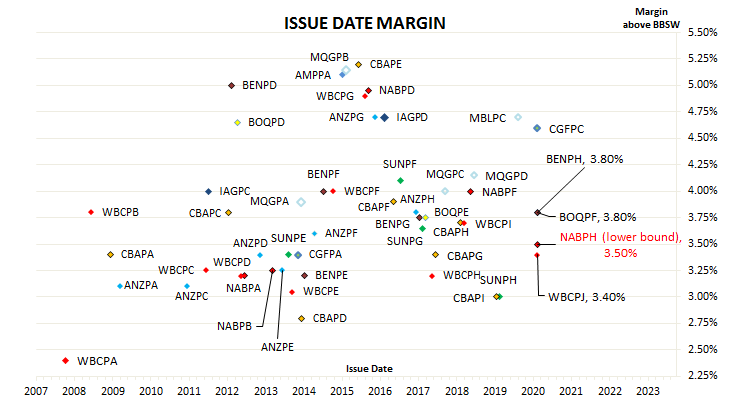Summary: NAB to issue new hybrid security; offer follows similar issues from Challenger, BoQ, Bendigo, Westpac; to partially fund redemption of Converting Preference Shares 2; first call date in December 2027; initially to pay around 3.5% (annualised, including franking credits).
In March 2020, just as the COVID-19 pandemic’s effects were really beginning to hit financial markets, NAB pulled its planned issue of Capital Notes 4 (ASX code: NABPG) securities. The new hybrids had been widely anticipated at the time as its first series of capital notes (ASX code: NABPC) was approaching its March 2020 call date. However, as almost all hybrid securities listed on the ASX had experienced relatively heavy selling, sending the median trading margin toward 600bps, NAB considered the withdrawal to be “in the best interests of relevant stakeholders…”
NAB now has another hybrid, its Converting Preference Shares 2 (ASX code: NABPB), approaching its call date and, as in March, a replacement security makes sense given APRA regulations require banks and other financial institutions to maintain equity capital as a ratio to assets above certain limits. National Australia Bank’s (NAB) latest hybrid security offer is in keeping with this tradition and it follows similar issues in recent weeks from Challenger, Bank of Queensland , Bendigo and Adelaide Bank and Westpac.
NAB plans to raise $750 million via an issue of Capital Notes 5 (ASX code: NABPH) securities, with the ability to raise more or less than this amount. The new securities will be perpetual, convertible, subordinated, unsecured, redeemable notes and the proceeds will be used for “general corporate purposes”. In practical terms the proceeds will partially fund the $1.7 billion redemption of NAB’s CPS 2 which have a December 2020 call date.
The new notes have some features in common with both equities and debt securities. Distributions are at the discretion of directors but they are calculated according to a set formula with reference to the $100 face value of the securities. The notes will qualify as Additional Tier 1 (AT1) capital under the Basel III bank regulatory framework, which means they have the now-standard “event” clauses which may lead to early conversion into ordinary shares or a write-off of the capital notes should APRA require it. In the event NAB were wound up and APRA had not already forced a write-off, its hybrids would rank above ordinary shares but below ordinary debt securities and other liabilities.
The new capital notes have an indicative distribution rate equivalent to 3 month BBSW plus a margin which lies in a range of 350bps to 370bps. The final margin will be determined by a “book build” which will be announced on 23 November 2020. A book build is a tender process managed by investment banks on behalf of the issuer in which investment institutions each place bids for a set volume at a price/yield. (This is the same way as the AOFM holds tenders to sell government bonds each week). If history is any guide, then the margin is likely to be set at the lower end.

